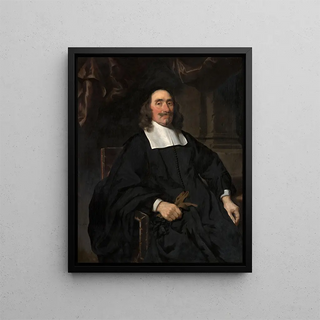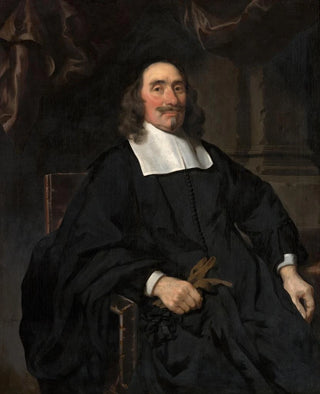Art print | Portrait of a gentleman (conflict of cases) - Nicolaes Maes


View from behind

Frame (optional)
In the fascinating world of 17th-century Dutch painting, Nicolaes Maes's "Portrait of a Gentleman (Casus Conflict)" stands out for its elegance and psychological depth. This artwork, which captures the essence of a man in all his complexity, invites the viewer to engage in a silent dialogue with the depicted subject. Through this portrait, Maes does not merely reproduce an image; he captures a soul, a moment frozen in time, where the gentleman's gaze seems to tell a story that each person can interpret in their own way. The light, composition, and meticulous details of the piece contribute to creating an atmosphere of intimacy and mystery, making this painting an essential masterpiece.
Style and uniqueness of the work
Nicolaes Maes's style is characterized by an exceptional mastery of light and shadow, a common trait among painters of the Amsterdam school. In "Portrait of a Gentleman (Casus Conflict)," the artist uses subtle lighting to accentuate facial features and the textures of clothing, thus creating a three-dimensional effect. The colors, though restrained, reveal a richness and depth that captivate the eye. Every detail, from the fabric of the suit to the reflections in the eyes, demonstrates careful observation and remarkable technical skill. This portrait is not limited to a simple representation; it is an exploration of identity and human emotions, a reflection of the society of the time when portraits were often symbols of status and power.
The artist and his influence
Nicolaes Maes, a pupil of Rembrandt, managed to establish himself on the artistic scene of his time thanks to his exceptional talent and keen sense of observation. His career, spanning several decades, is marked by a stylistic evolution that reflects his adaptation to the trends of his era while maintaining a personal essence. Maes not only contributed to the art of portraiture but also explored genre themes, depicting scenes of everyday life with unparalleled sensitivity. His influence endures, inspiring many artists who seek to capture the complexity

Matte finish

View from behind

Frame (optional)
In the fascinating world of 17th-century Dutch painting, Nicolaes Maes's "Portrait of a Gentleman (Casus Conflict)" stands out for its elegance and psychological depth. This artwork, which captures the essence of a man in all his complexity, invites the viewer to engage in a silent dialogue with the depicted subject. Through this portrait, Maes does not merely reproduce an image; he captures a soul, a moment frozen in time, where the gentleman's gaze seems to tell a story that each person can interpret in their own way. The light, composition, and meticulous details of the piece contribute to creating an atmosphere of intimacy and mystery, making this painting an essential masterpiece.
Style and uniqueness of the work
Nicolaes Maes's style is characterized by an exceptional mastery of light and shadow, a common trait among painters of the Amsterdam school. In "Portrait of a Gentleman (Casus Conflict)," the artist uses subtle lighting to accentuate facial features and the textures of clothing, thus creating a three-dimensional effect. The colors, though restrained, reveal a richness and depth that captivate the eye. Every detail, from the fabric of the suit to the reflections in the eyes, demonstrates careful observation and remarkable technical skill. This portrait is not limited to a simple representation; it is an exploration of identity and human emotions, a reflection of the society of the time when portraits were often symbols of status and power.
The artist and his influence
Nicolaes Maes, a pupil of Rembrandt, managed to establish himself on the artistic scene of his time thanks to his exceptional talent and keen sense of observation. His career, spanning several decades, is marked by a stylistic evolution that reflects his adaptation to the trends of his era while maintaining a personal essence. Maes not only contributed to the art of portraiture but also explored genre themes, depicting scenes of everyday life with unparalleled sensitivity. His influence endures, inspiring many artists who seek to capture the complexity






